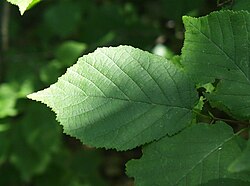| Corylus americana | |
|---|---|
 | |
| Scientific classification | |
| Kingdom: | Plantae |
| Clade: | Tracheophytes |
| Clade: | Angiosperms |
| Clade: | Eudicots |
| Clade: | Rosids |
| Order: | Fagales |
| Family: | Betulaceae |
| Genus: | Corylus |
| Species: | C. americana |
| Binomial name | |
| Corylus americana Marshall, 1785 | |
 | |
| Distribution of American hazelnut | |
Corylus americana, the American hazelnut [3] or American hazel, [4] is a species of deciduous shrub in the genus Corylus , native to the eastern and central United States and extreme southern parts of eastern and central Canada. [3] [5]



